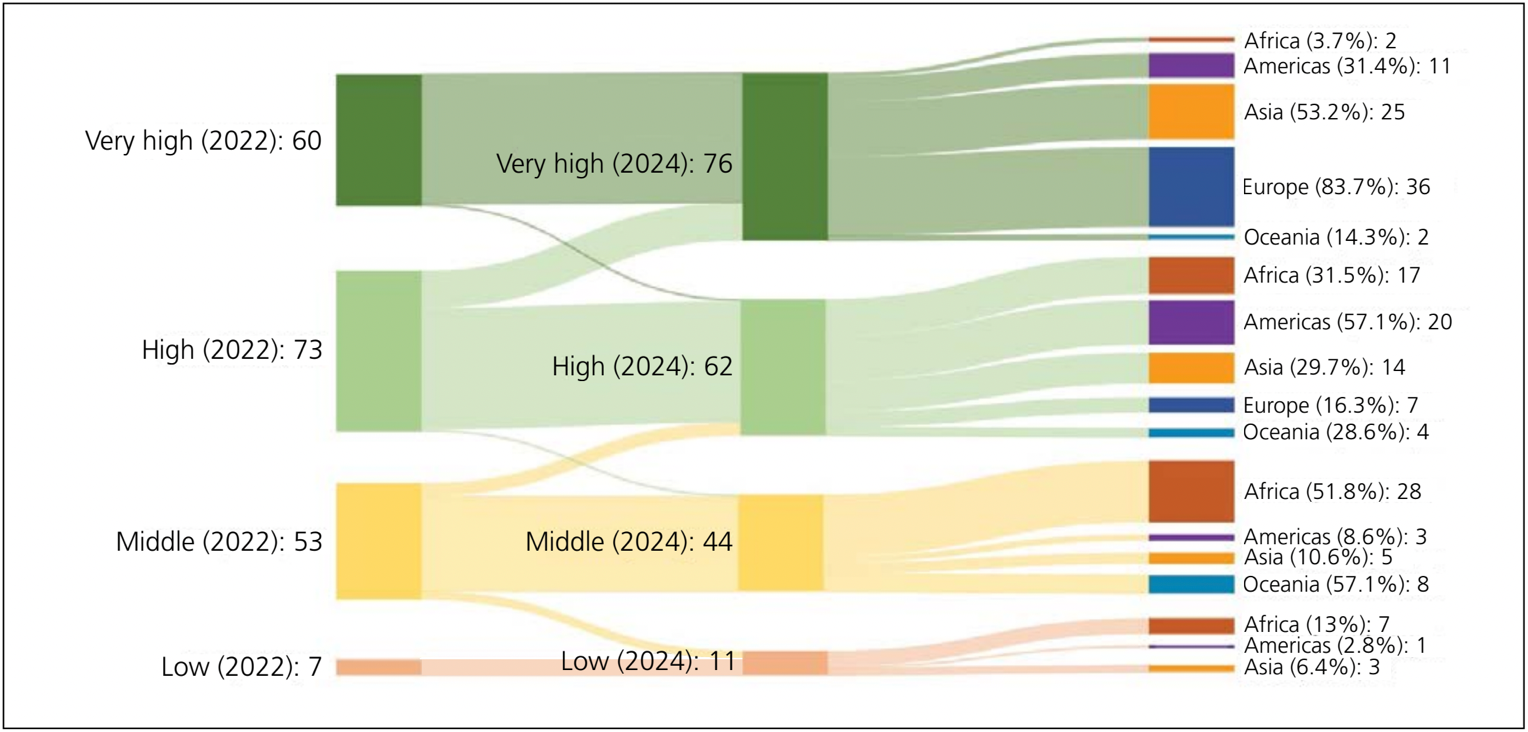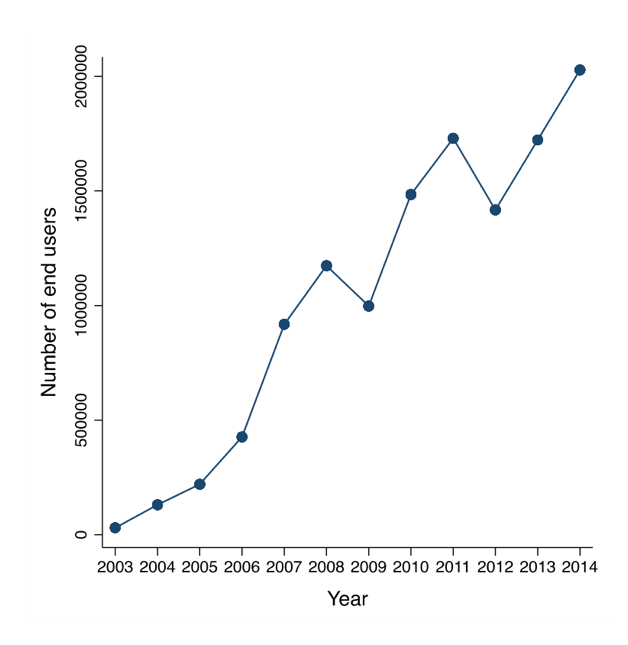-
CENTRES
Progammes & Centres
Location
 PDF Download
PDF Download 
Laura Larocchia and Alessandro Meneghella, “Overcoming Mistrust in Government Digitalisation,” ORF Issue Brief No. 801, May 2025, Observer Research Foundation.
Introduction
New data and technologies transform economies by creating jobs, enhancing the quality of life, and shaping cities of the future. The amount of data generated each year increased 74 times, from 2 zettabytes in 2010 to 149 zettabytes in 2024.[1] Many of these pieces of digital information have been absorbed by large language models (LLMs) and artificial intelligence (AI) systems to enhance their computation power.[2] In turn, companies and businesses use these technologies to enhance efficiency and productivity by reducing operational costs and creating economies of scale. For example, the retail sector uses AI tools to profile consumers and personalise marketing campaigns; financial institutions rely on machine learning models to detect fraud and automate decision-making processes. Individuals, too, have embraced AI for everyday tasks, as evidenced by ChatGPT reaching 100 million active users in only two months.[3]
The public sector is also adopting digital technologies. Institutions around the world are increasingly adopting technological systems to provide cost-effective and efficient public services.[4] According to the United Nations e-Government Development Index (EGDI)—a metric that evaluates a country’s readiness, capacity, and progress in using e-government to deliver public services[5]—many nations are advancing on their digitalisation journeys; 2024 was the first year in which countries with “very high” EGDI values made up the largest segment, accounting for 39 percent of the nations assessed.[6] The share of the global population lagging in digital government development declined from 45 percent in 2022 to 22.4 percent in 2024.[7]
Figure 1: Number of Countries by EGDI Group and the Movement of Countries Between EGDI Groups (2024)

Source: 2024 United Nations E-Government Survey[8]
Estonia and Singapore are leading the way in the public-sector adoption of digital technologies. Estonia began investing in public digital services in the late 1990s and early 2000s and is today one of the most digitalised countries worldwide: 98 percent of its citizens have a digital ID card, and nearly half (46.7 percent) vote via the internet.[9],[10],[11] Singapore launched enhanced Singpass in 2015, a smartphone app that residents can use to verify their identity and access over 2,000 public- and private-sector services.[12],[13],[14]
In 2010, India began laying the basis for what would later become a digital public infrastructure (DPI) that includes a digital identification tool, a running payments system, and a data-exchange network that communicate with each other and serve as the foundational layers on which to build, iterate, and innovate.[15],[16] The initiative has transformed the Indian economy, improving productivity and supporting equitable growth.[17] During India’s G20 presidency in 2023, leaders from member nations agreed on a shared vision for DPI and detailed principles and approaches that could be considered in its development and deployment in other countries.[a],[18]
However, there are several factors slowing the adoption of digital solutions. Structural barriers include low digital literacy, unequal connectivity opportunities, and a lack of economic resources. Another common obstacle, which exists beyond structural problems, is mistrust.[19] Trust is vital to shaping users’ willingness to adopt digital public services.[20],[21] The following section organises the research about mistrust and categorises mistrust into three types that can emerge as governments advance their digitalisation efforts.
Types of Mistrust
In 2022, over 43 percent of participants in a survey of several countries[b] stated that they would use technology for public services if they felt more confident about their security and privacy.[22] An increase in the amount of data available online is accompanied by heightening concerns about the use and possible misuse of this information. A 2024 survey by Censuswide revealed that 48 percent of Canadians fear the shift to digital public services due to security issues.[23] In some cases, people express greater mistrust towards institutions than towards businesses. Participants from the United Kingdom (UK) and Canada stated that they were more open to sharing data for personalised Netflix recommendations than for enhanced public service benefits.[24],[25]
There are various factors that can cause mistrust in the digitalisation of public services. When sharing information with private entities, users may exhibit an inherent bias toward consumption and the desired product or service, leading them to underestimate risks and overestimate benefits.[26] On the other hand, the nature of data required by the public sector, which includes highly sensitive personal information such as bank details or inheritance records, could make people more wary about storage and who will have access.[27] For instance, some citizens might be opposed to digital synergies between government departments as it might require sharing sensitive information, while others might be concerned about the presence of private providers in e-government projects.
While these collaborations are crucial to enable the public sector to take advantage of the latest available technologies, they also raise critical questions about the boundaries of data access and the safeguards necessary to prevent misuse by corporations. Moreover, the sensitivity of the collected records could make these records a prime target for malicious actors. Data breaches or cyberattacks can disrupt essential public services, cause financial losses, damage reputations, and erode public trust.[28],[29] In November 2019, ransomware affecting payment systems forced Pemex, Mexico’s state-owned petroleum company, to shut down computers nationwide.[30] In 2023, Kenya faced a distributed-denial-of-service attack[c] that overwhelmed servers of the eCitizen portal and M-Pesa, the country’s mobile payment system, which resulted in over 5,000 public services, including passport applications, electricity bill payments, and railway ticket bookings, being inaccessible for more than 48 hours.[31]
Mistrust in Machine-Driven Judgements
Citizens’ trust in digital public services is further undermined by the potential biases and lack of transparency in the algorithms that are used to analyse datasets, draw inferences, or interpret citizen-submitted information.[32] These tools often rely on datasets that fail to reflect the complexity and diversity of a population. The opacity of the algorithms also makes it difficult to trace the logic behind an error or bias which, in turn, makes it difficult to correct inaccuracies and establish accountability.[33],[34] In 2014, Amazon began using computer programmes to evaluate job applicants’ resumes. After a few months, it became clear that for technical roles, the system had a disproportionate preference for male candidates. The company later dismantled the project.[35],[36] The algorithm had been trained on patterns observed in resumes submitted to Amazon over a 10-year period, during which the tech industry—and Amazon’s own workforce—was predominantly male.
The risks are higher when governments adopt such technologies, as any inaccuracies can have social and economic implications. In 2013, in the Netherlands, the Dutch Tax and Customs Administration used algorithms to create risk profiles of individuals applying for childcare benefits. Indicators such as “foreign-sounding names” and “dual nationality” were used to identify potential fraud. This led to thousands of low- and middle-income families being forced to repay benefits obtained legally, amounting to thousands of euros, without the possibility of instalment plans. Some lost their homes and jobs, and in over 1,000 cases, children were separated from their families and placed in state custody.[37]
Public services can be time-consuming. For example, in 2023, the average Canadian spent 28 hours navigating government services, and the average UK citizen, over 12 hours.[38],[39]
Digitalisation could present an opportunity to simplify access and save time. Indeed, many citizens are requesting it: 89 percent of millennials expect organisations to use technology to enhance customer experience, and 73 percent prioritise online interactions over in-person.[40] Additionally, 66 percent of British citizens would prefer fully online digital public services within the next few years.[41]
However, merely creating a digital version of a public service is not enough; effective design is crucial. Many government websites are not regularly updated and have information that is difficult to find. According to Accenture research, more than half of the people surveyed in North America, Europe, and Asia-Pacific consider accessing public services to be cumbersome.[42] A 2023 White House report highlighted that 45 percent of federal websites in the United States (US) are not mobile-friendly, 60 percent fail to meet accessibility standards, and 80 percent do not use the US Web Design System code.[43] In the 2022 Digital Trends – Public Sector in Focus report, 37 percent of public leaders admitted that their services fell short of people’s expectations.[44]
Poor user experience (UX) in public services can be traced to economic factors, particularly a lack of competition and a “captive audience” of users. Unlike private companies, governments do not need to attract customers. A government website is often the only way to resolve specific issues, such as applying for passports or paying taxes. With no competitors, there is little pressure to prioritise usability. Instead, the focus is primarily on meeting regulatory and legal requirements, often at the expense of user convenience.[45]
This lack of pressure could block the path to digitalisation. When people become dissatisfied with poorly designed interfaces, they might return to traditional human interactions which, despite entailing long waiting times, can be perceived as more reliable for resolving issues promptly. For instance, a citizen attempting to obtain a birth certificate online may opt to visit a government office if the website does not work properly or if the designated chatbot keeps providing the wrong answer.
If the public sector wants to truly benefit from digitalisation, it has to invest in efficient, intuitive, and accessible services that meet the expectations of a public that is increasingly accustomed to the superior UX offered by private companies. These efforts could also create positive externalities in other areas of intervention. According to the same Accenture report cited earlier, 53 percent of the people surveyed stated that they would be willing to share more personal data with government agencies for greater convenience and efficiency.[46]
By aligning digital public services with modern design principles and user-centric approaches, governments can enhance citizen satisfaction, foster trust in digital systems, and capitalise on the transformative potential of digitalisation.
Keys to Overcoming Mistrust
Although mistrust derives from various causes, the common factor is citizens’ perception that they are providing something without equivalent value in return. Users are unwilling to share more data, compromise their freedom, or spend more time accessing public services unless they can gain tangible benefits.
Higher levels of privacy, effective regulations, and user-friendly interfaces are vital. However, these measures alone may not be enough to fully overcome mistrust, which depends not only on how secure and effective public services are but also on how secure and effective people perceive them to be.[47] Users tend to perceive physical services as more reliable than online alternatives, human judgements as fairer than automated ones, and paper documents as more secure than their digital counterparts. To drive meaningful change, governments must shift citizens’ perceptions and attitudes. To this end, they can implement three key actions that leverage communication and public engagement to build connections and foster trust.
When a government adopts a technological innovation, the benefits may not always be immediately clear to citizens and may result in users being sceptical about the utility of the new solution and deciding to preserve the traditional ways. The lack of proper communication can lead to lower levels of trust and a slowdown in digital transformation initiatives, widening the gap between digital solutions and citizens’ preferences.[48]
Public administrations must bridge this gap by communicating transformation more effectively. They need to explain what a new solution is, why it is important, and how it can benefit citizens. Transparency about which technologies are being adopted, why specific data is requested, and how automated decision-making systems work are essential to strengthen public trust. Providing citizens with this information would enable them to interact with digital services more effectively and reassure them about issues such as security and privacy.
Estonia, for example, has prioritised transparency and public awareness, ensuring that citizens understand not just the “how” but also the “why” behind digital transformation. In 2017, when Czech cybersecurity researchers discovered a critical vulnerability in Estonia’s eID system, the Estonian government made the news public instead of downplaying the situation. A collaborative effort between the public and private sectors followed, and the issue was mitigated without any damage. Rather than stoking fear, the incident reinforced confidence in the country’s ability to effectively manage cyber threats.[49]
Besides crisis management, Estonia invests in large-scale communication campaigns to educate citizens about new digital initiatives and their benefits. One example is X-Road, the country’s open-source platform for secure data exchange between organisations. The government has launched numerous campaigns to raise awareness in order to encourage its use and to ensure that individuals and businesses understand its benefits.[50] These efforts have led to the increased adoption of X-Road, with peak usage observed in 2006 and 2009, when extensive communication campaigns were carried out.[51]
Figure 2: Growth of End-Users in X-Road (2003-2014)

Communication campaigns must be shared through channels that connect with people so that the target audience can internalise them. In 1879, Naples built a funicular railway to allow citizens to reach the top of Mount Vesuvius. However, people were afraid of the innovation and preferred to climb either by foot or on a donkey. After a year of low ticket sales, journalist Peppino Turco and musician Luigi Denza devised a communication campaign. They produced a song, Funiculì, Funiculà, that encouraged people to take the funicular to the top of the volcano. The song became popular and resulted in increased public trust in the technological innovation and, consequently, in a rise in ticket sales.[53],[54]
For citizens to embrace digital services, governments must first address citizens’ concerns and explain the tangible benefits of new and innovative services. By fostering a culture of transparency, engaging the public through the appropriate communication channels, and responding openly to security challenges, institutions can build the trust necessary for digital transformation to thrive.
Introducing a new and unfamiliar technology abruptly might raise scepticism, especially if a previous attempt at digitalisation has failed. Governments should guide citizens through the digitalisation process, proposing incremental changes that allow the public to experience the benefits of each initiative. This approach is crucial to instil confidence and convince individuals of the validity of projects. Moreover, small, systematic steps can help test the reliability of new technology and intervene promptly in case of incidents or data breaches, which can limit associated risks.
For example, India’s DPI is the result of 10 years of work. For payment services, small-scale payment projects were introduced first.[e],[55] It was only after citizens realised the benefits of the initiative that the Indian government articulated a comprehensive Unified Payments Interface, which was widely adopted due to the trust that the government had built over time.[56]
The development of the Diia app in Ukraine followed a similar course. The service was developed at the beginning of the war with Russia to enable the Ukrainian government to provide immediate economic support to its citizens. As the war continued, the app evolved; today, it includes more than 120 government services, allowing citizens to perform actions such as accessing personal documents and requesting legal documents.[57]
AI and machine learning have altered people’s perceptions of digital tools. Modern digital tools fail more and learn faster; they depend on making mistakes in order to improve their ability to provide correct responses. Therefore, to improve precision, algorithms need to be trained as extensively as possible by a wide range of users.
Governments and public institutions play a pivotal role in “humanising” technology by engaging citizens as active participants and co-authors of change. Specifically, they must foster awareness that technology is prone to errors and emphasise the importance of citizen involvement in reporting these mistakes. By doing so, they can facilitate timely corrections and improvements, ensuring that technological systems evolve to serve the public good.
In 2019, Poste Italiane, the Italian national postal service, introduced an AI-powered customer-care service. The tool was designed to handle common and routine requests, allowing customer service agents to focus on more complex tasks. From the start, Poste Italiane tried to “humanise” its chatbot by giving it a friendly face. Moreover, it included phrases such as “Time is my friend: it enhances my skills and improves me”, which broke down human-machine barriers and forced users to feel empathy for the digital assistant.[58] Since its launch, the tool has handled over 40 million interactions, accounting for 62 percent of total requests. It has received high ratings, with an average score above 9/10 for the voicebot and 4/5 for the chatbot.[59],[60]
Such initiatives can help citizens view technology not as an imposition from above but as a tool whose success depends on collective effort and the contributions of each individual. This approach can also ensure that citizens are no longer subjects to be persuaded but active participants whose feedback and proactive approach can help institutions adopt and improve their digital services.
Pathways to a Fully Developed DPI
As governments advance in their digitalisation efforts, fostering trust through awareness, tangible benefits, and citizen empowerment will be essential to building a fully-fledged DPI. Despite variations in DPI implementation—which range from digital identity and data-sharing systems to digital payments and digital post and notifications—all applications share two key characteristics: the propensity to digitalise more services and the need to exchange data and information between multiple actors, both public and private. The path to overcoming the challenges associated with adopting such tools cannot rely solely on structural solutions; it also depends on better communication and collaboration.
Knowledge-sharing among nations can help countries accelerate their digitalisation process. One example is the Global Digital Public Infrastructure repository, a database launched during India’s G20 presidency, that collates the initiatives promoted by member countries in building their DPI.[61]
Involving different actors, such as companies and citizens, in each country’s DPI journey can instil a sense of ownership and responsibility. This engagement would ensure that everyone, from the individual to the corporate level, is a participant in and promoter of a transformative process aimed at improving the efficiency, transparency, and equality of digital public services.
Endnotes
[a] This shared vision is as follows: “[A] set of shared digital systems that should be secure and interoperable, and can be built on open standards and specifications to deliver and provide equitable access to public and / or private services at societal scale and are governed by applicable legal frameworks and enabling rules to drive development, inclusion, innovation, trust, and competition and respect human rights and fundamental freedoms.” See: https://www.mea.gov.in/bilateral-documents.htm?dtl/37084/G20_New_Delhi_Leaders_Declaration
[b] Those surveyed were from Australia, Canada, France, Germany, Italy, Japan, Singapore, Spain, the United Kingdom, and the United States.
[c] A Distributed Denial-of-Service (DDoS) attack is a malicious attempt to disrupt the normal functioning of a website, server, or network by overwhelming it with a flood of internet traffic from multiple sources. The goal is to make the targeted system slow, inaccessible, or entirely non-functional for legitimate users.
[d] The number of end-users increased from approximately 30,000 in 2003 to just over 2 million by 2014, corresponding to an average annual growth rate of around 153,000 users over the 12-year period.
[e] The Aadhaar-enabled Payment System (AePS) was introduced in 2009, allowing users—particularly in rural and remote areas—to access financial services through biometric authentication. This was followed in 2010 by the launch of the Immediate Payment Service (IMPS) by the National Payments Corporation of India (NPCI), which enabled real-time, 24/7 money transfers via mobile phones. In 2016, NPCI introduced the Unified Payments Interface (UPI), a platform that facilitated real-time money transfers through mobile devices without the need for detailed bank information.
[1] Statista, “Amount of Data Created, Consumed, and Stored 2010-2023, With Forecasts to 2028,” November 21, 2024, https://www.statista.com/statistics/871513/worldwide-data-created/.
[2] IBM, “How Large Language Models Work,” https://www.ibm.com/think/topics/large-language-models#:~:text=for%20more%20information.-,How%20large%20language%20models%20work,sequential%20data%20like%20text%20input.
[3] Krystal Hu, “ChatGPT Sets Record for Fastest-growing User Base - Analyst Note,” Reuters, February 2, 2023, https://www.reuters.com/technology/chatgpt-sets-record-fastest-growing-user-base-analyst-note-2023-02-01/.
[4] Romina Bandura, Madeleine McLean, and Salome Girgvliani, “Advancing Digital Transformation and Digital Public Infrastructure: The Role of the Private Sector,” October 15, 2024, https://www.csis.org/analysis/advancing-digital-transformation-and-digital-public-infrastructure-role-private-sector.
[5] United Nations, “E-Government Survey 2024 Accelerating Digital Transformation for Sustainable Development,” 2020, https://publicadministration.un.org/egovkb/en-us/Reports/UN-E-Government-Survey-2024.
[6] United Nations, “E-Government Survey 2024 Accelerating Digital Transformation for Sustainable Development.”
[7] United Nations, “E-Government Survey 2024 Accelerating Digital Transformation for Sustainable Development.”
[8] United Nations, “E-Government Survey 2024 Accelerating Digital Transformation for Sustainable Development.”
[9] Edvin Lars, “Story - e-Estonia,” e-Estonia, April 7, 2025, https://e-estonia.com/story/.
[10] UNDP, “Understanding Digital Government Part 2: Digital Public Infrastructure,” https://www.undp.org/trinidad-and-tobago/blog/understanding-digital-government-part-2-digital-public-infrastructure.
[11] Esmh, “e-Governance: The Estonian Case,” European Science-Media Hub, December 10, 2024, https://sciencemediahub.eu/2019/10/16/e-governance-the-estonian-case/.
[12] “Understanding Digital Government Part 2: Digital Public Infrastructure.”
[13] Christine Zhenwei Qiang and Cheow Hoe Chan, “How Singapore’s National Digital Identity and Government Digital Data Sharing Platform Fosters Inclusion and Resilience,” World Bank Blogs, March 16, 2024, https://blogs.worldbank.org/en/digital-development/how-singapores-national-digital-identity-and-government-digital-data-sharing.
[14] Government Technology Agency of Singapore, Singapore Government, “SingPass Factsheet,” https://www.tech.gov.sg/files/media/media-releases/Annex_A___SingPass_Factsheet.pdf.
[15] “See Why India’s Digital Public Infrastructure Is Now Attracting Worldwide Interest,” World Economic Forum, September 10, 2024, https://www.weforum.org/stories/2023/08/the-international-significance-of-indias-digital-public-infrastructure/.
[16] Cate Hansberry, “Global DPI Models: Lessons from India, Brazil, and Beyond - Atlantic Council,” Atlantic Council, November 1, 2024, https://www.atlanticcouncil.org/in-depth-research-reports/issue-brief/global-dpi-models-lessons-from-india-brazil-and-beyond/.
[17] Hansberry, “Global DPI Models: Lessons from India, Brazil, and Beyond - Atlantic Council.”
[18] Ministry of External Affairs, Government of India, “G20 New Delhi Leaders’ Declaration,” https://www.mea.gov.in/bilateral-documents.htm?dtl/37084/G20_New_Delhi_Leaders_Declaration.
[19] Alberto Savoldelli, Cristiano Codagnone, and Gianluca Misuraca, “Understanding the E-Government Paradox: Learning From Literature and Practice on Barriers to Adoption,” Government Information Quarterly 31 (June 1, 2014): S63–71, https://doi.org/10.1016/j.giq.2014.01.008.
[20] Mahmud Akhter Shareef et al., “e-Government Adoption Model (GAM): Differing Service Maturity Levels,” Government Information Quarterly 28, no. 1 (October 21, 2010): 17–35, https://doi.org/10.1016/j.giq.2010.05.006.
[21] Diego Mesa, “Digital Divide, E-Government and Trust in Public Service: The Key Role of Education,” Frontiers in Sociology 8 (February 21, 2023), https://doi.org/10.3389/fsoc.2023.1140416.
[22]Eyal Darmon, Kevin Ellenwood, and Jenny Brodie, “Public Service Experience in the Public Sector,” Accenture, April 23, 2025, https://www.accenture.com/us-en/insights/public-service/experience-new-lens.
[23] “Research: Trust Lacking in Digital Public Services,” July 4, 2024, https://nortal.com/insights/research-trust-lacking-in-digital-public-services.
[24] Statista, “Global Online Users Concerns About Misuse of Personal Data Q3 2020-Q3 2024,” February 11, 2025, https://www.statista.com/statistics/1382829/concerns-personal-data-misuse/.
[25] “Research: Trust Lacking in Digital Public Services.”
[26] Susanne Barth and Menno D.T. De Jong, “The Privacy Paradox – Investigating Discrepancies Between Expressed Privacy Concerns and Actual Online Behavior – a Systematic Literature Review,” Telematics and Informatics 34, no. 7 (April 28, 2017): 1038–58, https://doi.org/10.1016/j.tele.2017.04.013.
[27] Rami Mourtada, Lars Littig, and Miguel Carrasco, “Digital Government in the GCC: Accelerating Citizen Trust,” BCG Global, September 15, 2022, https://www.bcg.com/publications/2021/digital-government-services-help-build-trust-of-gcc-citizens.
[28]“Digital Security Risk Management for Economic and Social Prosperity,” OECD, October 1, 2015, https://www.oecd.org/en/publications/2015/10/digital-security-risk-management-for-economic-and-social-prosperity_g1g5c3dc.html.
[29] Hansberry, “Global DPI Models: Lessons from India, Brazil, and Beyond - Atlantic Council.”
[30] Adriana Barrera and Raphael Satter, “Hackers Demand $5 Million From Mexico’s Pemex in Cyberattack,” Reuters, November 13, 2019, https://www.reuters.com/article/business/hackers-demand-5-million-from-mexicos-pemex-in-cyberattack-idUSKBN1XN05W/.
[31] C1p1t, “Kenya’s Digital Infrastructure Under Threat? A Look at Anonymous Sudan’s Thwarted Cyberattack Attempt and Its Implications for Kenya’s Digital Systems - Centre for Intellectual Property and Information Technology Law,” Centre for Intellectual Property and Information Technology Law, August 22, 2023, https://cipit.org/kenyas-digital-infrastructure-under-threat-a-look-at-anonymous-sudans-thwarted-cyberattack-attempt-and-its-implications-for-kenyas-digital-systems/.
[32] Anneke Zuiderwijk, Yu-Che Chen, and Fadi Salem, “Implications of the Use of Artificial Intelligence in Public Governance: A Systematic Literature Review and a Research Agenda,” Government Information Quarterly 38, no. 3 (March 23, 2021): 101577, https://doi.org/10.1016/j.giq.2021.101577.
[33] Do Better by Esade, “Algorithms Are Driving Inequality, Not Eliminating It,” September 2024, https://dobetter.esade.edu/en/algorithms-equality.
[34] Simon Chesterman, “Through a Glass, Darkly: Artificial Intelligence and the Problem of Opacity,” The American Journal of Comparative Law 69, no. 2 (April 28, 2021): 271–94, https://doi.org/10.1093/ajcl/avab012.
[35] Jabari Simama, “Biased AI’s Challenges for Government Leaders,” Governing, January 14, 2024, https://www.governing.com/policy/biased-ais-challenges-for-government-leaders.
[36] Jeffrey Dastin, “Insight - Amazon Scraps Secret AI Recruiting Tool That Showed Bias Against Women,” Reuters, October 10, 2018, https://www.reuters.com/article/world/insight-amazon-scraps-secret-ai-recruiting-tool-that-showed-bias-against-women-idUSKCN1MK0AG/.
[37] “Parliamentary Question | the Dutch Childcare Benefit Scandal, Institutional Racism and Algorithms | O-000028/2022 | European Parliament,” European Parliament, https://www.europarl.europa.eu/doceo/document/O-9-2022-000028_EN.html.
[38] “Research: Trust Lacking in Digital Public Services.”
[39] “Research: Trust Lacking in Digital Public Services.”
[40] Josh Koenig, “How Government Websites Can Prioritize User Experience–And Why They Should,” Forbes, August 13, 2024, https://www.forbes.com/councils/forbestechcouncil/2024/08/06/how-government-websites-can-prioritize-user-experienceand-why-they-should/.
[41] “Research: Trust Lacking in Digital Public Services.”
[42] “Accenture Report Finds People Want Easy-to-Use Government Customer Services,” https://newsroom.accenture.com/news/2022/accenture-report-finds-people-want-easy-to-use-government-customer-services.
[43] The White House, “FACT SHEET: Building Digital Experiences for the American People,” October 3, 2023, https://www.whitehouse.gov/omb/briefing-room/2023/09/22/fact-sheet-building-digital-experiences-for-the-american-people/.
[44] Adobe, “2022 Digital Trends,” 2022, https://business.adobe.com/content/dam/dx/apac/resources/digital-trends-2022/adobe-digital-trends-2022-public-sector-in-focus.pdf.
[45] Noura Aleisa, “Key Factors Influencing the E-government Adoption: A Systematic Literature Review,” Deleted Journal 1, no. 1 (March 15, 2024): 14–31, https://doi.org/10.1108/jidt-09-2023-0016.
[46]“Accenture Report Finds People Want Easy-to-Use Government Customer Services.”
[47] Barth and De Jong, “The Privacy Paradox – Investigating Discrepancies Between Expressed Privacy Concerns and Actual Online Behavior – a Systematic Literature Review.”
[48] Mila Josifovska, “Communicating Digital Transformation to the Citizens – an Important Contribution to Bridging the Gap - Metamorphosis,” Metamorphosis - Foundation for Internet and Society, April 24, 2023, https://metamorphosis.org.mk/en/blog/communicating-digital-transformation-to-the-citizens-an-important-contribution-to-bridging-the-gap/.
[49] “Digital Public Infrastructure: 7 Lessons From Estonia,” World Economic Forum, September 10, 2024, https://www.weforum.org/stories/2021/10/how-to-build-digital-public-infrastructure-estonia/.
[50] Edvin Lars, “X-Road - e-Estonia,” e-Estonia, February 4, 2025, https://e-estonia.com/solutions/x-road-interoperability-services/x-road/.
[51] Kristjan Vassil, “Estonian E-Government Ecosystem: Foundation, Applications, Outcomes,” 2011, https://thedocs.worldbank.org/en/doc/165711456838073531-0050022016/original/WDR16BPEstonianeGovecosystemVassil.pdf.
[52] Vassil, “Estonian E-Government Ecosystem.”
[53] Redazione, “La Canzone Classica Napoletana:Come Nacque Funiculì Funiculà? &Ndash; Senza Linea,” Senza Linea, April 8, 2018, https://www.senzalinea.it/giornale/la-canzone-classica-napoletanacome-nacque-funiculi-funicula/.
[54] Cristiano Carriero, “Racconta la vita di chi ti ascolta, non la tua,” 2024.
[55] Amit Kumar Singh, Vivek Kumar Gupta, and Krishna Kumar Agarwal, “Digital Revolution: Analyzing the Growth of Payment Systems in India,” September 2024, https://ijsdr.org/papers/IJSDR2409036.pdf.
[56] Erin Watson, “The India Stack as a Potential Gateway to Global Economic Integration,” Observer Research Foundation, March 22, 2024, https://www.orfonline.org/research/the-india-stack-as-a-potential-gateway-to-global-economic-integration.
[57] Hansberry, “Global DPI Models: Lessons from India, Brazil, and Beyond - Atlantic Council.”
[58] “Poste, L’Assistente Digitale Di Poste Italiane,” https://www.poste.it/assistente-digitale-poste/.
[59] SMAU, https://www.smau.it/casi-di-successo/poste-italiane-quando-risolvere-diventa-anche-personalizzare.
[60] Poste Italiane, “Premio Innovazione SMAU 2022,” SMAU, 2022, https://www.smau.it/FRONTEND/Casi%20Successo%20PDF/POSTE%20ITALIANE_Premio%20Innovazione%202022.pdf
[61] Digital Public Infrastructure, https://www.dpi.global/.
The views expressed above belong to the author(s). ORF research and analyses now available on Telegram! Click here to access our curated content — blogs, longforms and interviews.

Laura Larocchia is a manager at Disal Consulting and social activist with WEF’s Global Shapers, with a passion for cultural transformations, digital progress and community ...
Read More +
Alessandro Meneghella holds a degree in Economics from the London School of Economics and Political Science (LSE). He currently works at Disal Consulting, where he ...
Read More +